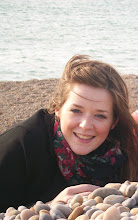Friday, 23 April 2010
My Finished Trailer
Any use of music in this film complies with 'Fair Dealing' under the 1988 Copyright Designs and Patents Act (UK), Sections 6(i) and 6(ii); Fair dealing is a term used to describe some limited activities that are allowed without infringing copyright. Briefly these are as follows:Section 6i. Research and private studyCopying parts of a literary, dramatic, musical or artistic work or of a typographical arrangement of a published edition for the purpose of research or private study is allowed under the following conditions:· The copy is made for the purposes of research or private study.· The copy is made for non-commercial purposes.· The source of the material is acknowledged.· The person making the copy does not make copies of the material available for a number of people.
Thursday, 22 April 2010
Magazine
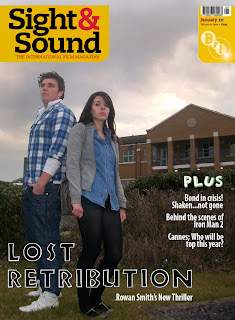 My final magazine cover (click to enlarge)
My final magazine cover (click to enlarge)My magazine cover was the second of the two individual tasks that I completed outside of lesson time. I worked by the same process as my website, researching existing media texts in order to inform my own media product. In the same way I created my website homepage, I again used Photoshop to create my magazine cover, giving me more opportunity to evolve my skills with the programme. By using the same process as when making my website, I think that I have created a magazine cover that reflects the chosen genre of our film, as well as following the codes and conventions of my chosen magazine. The two magazines that I chose to look at for my research were 'Empire' and 'Sight and Sound'. I chose to look at these because I think they are the two most popular magazines, and both offer a different approach towards the same kind of thing - focusing on films. I also conducted a SWOT Analysis of my skills, prior to conducting my research.
Here is the research I did on each magazine, with notes about aspects that stood out to me on each issue cover. Click on each image to enlarge it and read my notes.
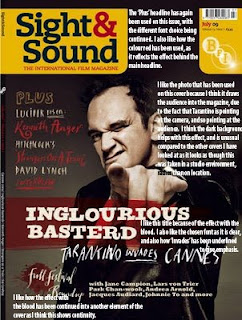

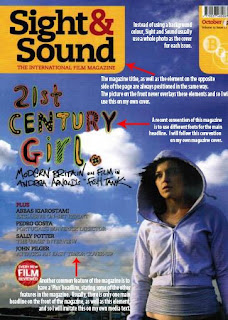
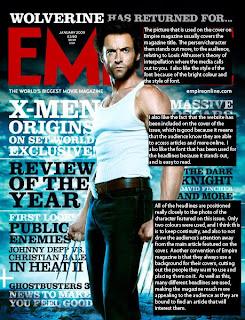
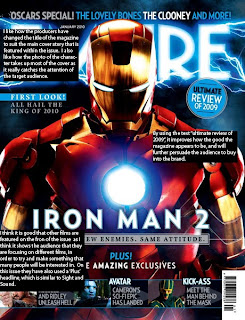

After carrying out my research, I decided that I wanted to create a cover for Empire, because I like the way in which they use backgrounds to help emphasise the photo on the cover of the issue. I also like that they use many different headlines to promote what is featured within the magazine, and think that this was the better option of my two choices to successfully promote my film, with regards to my chosen genre and target audience. With this in mind, I took pictures of both of the actors that were featured in my trailer, as I wanted to used the idea of having a close up of a character from the film, as seen in my Sight and Sound research.
Because Empire use backgrounds on their front covers, I decided to make my own using the stamps in Photoshop. This is the first background idea that I came up with, however I didn't think this would work with the cover that I wanted to create. I thought that the colours wouldn't work with my film because on my website I used a red font, and so to keep contiunuity, I had planned to use a red font on my magazine cover too. I think the pattern was ok, although I think i should have added something else, as there are still quite a lot of white areas, which isn't common with the Empire covers I looked at.
 With this in mind from making my first background, I chose to make a new one. This time I changed the colour scheme, instead using reds and blacks, to match the colour font that I had previously decided to use. Although I think my second attempt at making a background turned out better than my first, I was still unsure whether it would work with my magazine cover, due to wanting to use a red font. I thought that if I used red font as well as having a red background, there may have been too much red, and the cover wouldn't have had the effect that I wanted it to have - to tempt my target audience into buying the magazine.
With this in mind from making my first background, I chose to make a new one. This time I changed the colour scheme, instead using reds and blacks, to match the colour font that I had previously decided to use. Although I think my second attempt at making a background turned out better than my first, I was still unsure whether it would work with my magazine cover, due to wanting to use a red font. I thought that if I used red font as well as having a red background, there may have been too much red, and the cover wouldn't have had the effect that I wanted it to have - to tempt my target audience into buying the magazine.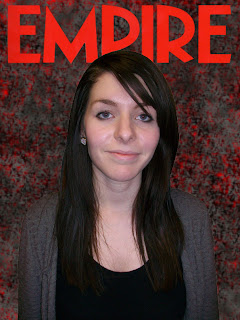 Although I wasn't entirely sure if my second attempt at making a background would work, I decided to stick with it and see what I could do. After making my background, I cut out a picture of one of my actors using the magic wand tool, and then put it onto the background. I then did the same with the Empire logo, and then using the layer panel, I moved the layers around so that the photo of my actor was over the top of the magazine title - a closely followed convention of Empire as seen in all the issues I looked at for my research. After doing this, I felt that as a magazine cover this wouldn't work, mainly because I felt that my background wasn't right, and that maybe I had chosen the wrong type of photo to use.
Although I wasn't entirely sure if my second attempt at making a background would work, I decided to stick with it and see what I could do. After making my background, I cut out a picture of one of my actors using the magic wand tool, and then put it onto the background. I then did the same with the Empire logo, and then using the layer panel, I moved the layers around so that the photo of my actor was over the top of the magazine title - a closely followed convention of Empire as seen in all the issues I looked at for my research. After doing this, I felt that as a magazine cover this wouldn't work, mainly because I felt that my background wasn't right, and that maybe I had chosen the wrong type of photo to use.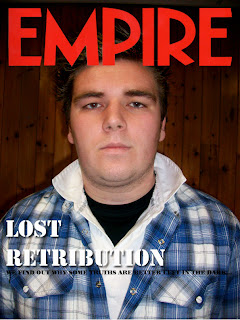 Because I didn't like my previous attempt at creating an Empire front page, I decided to start again, this time using the other main actor from our trailer. I decided to use the background that was already on the photo, as I felt that it was plain enough to use on an Empire cover. I touched up the photo, for example changing the levels, and using the healing brush as well as the burning in tool to make it more useful as an Empire cover. I then started to create titles, starting with the main title about my film. I changed my mind about using red as I though that it wouldn't look right if I used red because of the colours within the photo. I also thought of a headline that I thought worked well for an issue of Empire, telling the audience that if they read the magazine they will find out what we think in response to the headline. Although I was relatively happy with this attempt compared to my previous go, when talking to my peers, they felt that it didn't work as an Empire issue, mainly due to the fact that I hadn't cut out the photo and put it onto a different background. Because of this, I attempted to cut out this photo, as I felt that it was a better photo to use than my previous choice, however I couldn't cut it out to an appropriate standard due to aspects such as the background and the actor's hair. After this second attempt, I changed my idea completely and switched to creating a Sight and Sound front cover, as I thought that I would be able to create a more convincing media product, that would look closer to a professional media text.
Because I didn't like my previous attempt at creating an Empire front page, I decided to start again, this time using the other main actor from our trailer. I decided to use the background that was already on the photo, as I felt that it was plain enough to use on an Empire cover. I touched up the photo, for example changing the levels, and using the healing brush as well as the burning in tool to make it more useful as an Empire cover. I then started to create titles, starting with the main title about my film. I changed my mind about using red as I though that it wouldn't look right if I used red because of the colours within the photo. I also thought of a headline that I thought worked well for an issue of Empire, telling the audience that if they read the magazine they will find out what we think in response to the headline. Although I was relatively happy with this attempt compared to my previous go, when talking to my peers, they felt that it didn't work as an Empire issue, mainly due to the fact that I hadn't cut out the photo and put it onto a different background. Because of this, I attempted to cut out this photo, as I felt that it was a better photo to use than my previous choice, however I couldn't cut it out to an appropriate standard due to aspects such as the background and the actor's hair. After this second attempt, I changed my idea completely and switched to creating a Sight and Sound front cover, as I thought that I would be able to create a more convincing media product, that would look closer to a professional media text.Here are the stages I went through to reach my final magazine cover. Click on each picture to enlarge it and read my notes.
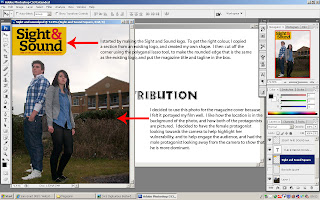
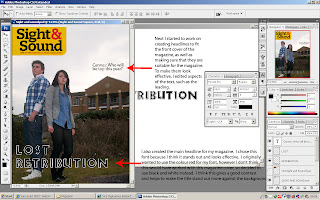
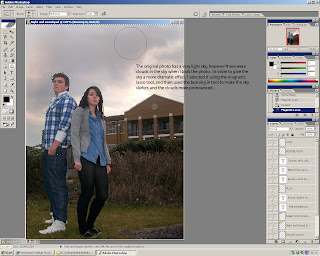
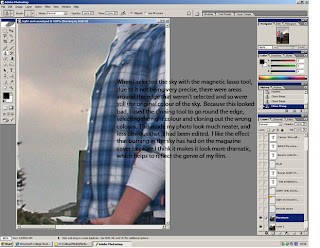
After several times at re-strating my magazine, I was finally happy with my end result. I think the image I chose to use was the right choice for a Sight and Sound magazine, as one of their conventions is to use an image that has been taken in a location, and then use the whole image on the cover of each issue, as opposed to Empire who cut out their photos and put them onto new backgrounds. Although I haven't used many headlines on my own cover, there is a reason for this, with it being that on some Sight and Sound issues that I looked at, the producer's only used the main title as well as the 'Plus' headline. I think this is effective because it draws the audience into buying the magazine to find out what else is in the issue. I also like how they largely focus on one film as opposed to Empire who feature many films on the front cover of each of their issues.
Sunday, 18 April 2010
Evaluative Commentary
When creating my own viral campaign, I focused on using existing media texts - websites, radio adverts, magazine covers and teaser trailers - in order to properly inform my own work, as well as create products that would be suitable for my chosen target audience. By doing this, the codes and conventions of my chosen genre - a psychological thriller - could also be used, thus further ensuring that the correct audience is targeted in terms of age, demographic and psychographic factors. By sticking to the codes and conventions of the genre, the products that I produced were also fully understandable to our chosen audience, making the campaign much more effective as a whole.
With ideas in mind for the trailer i wanted to produce, I researched texts of a similar genre to the one my group had chosen, focusing on the trailers of 'Cloverfield' (Matt Reeves, 2008), 'Inception' (Christopher Nolan, 2010) and 'Inglourious Basterds' (Quentin Tarentino, 2009). The aim of the trailer I intended to create was to portray an enigma that my chosen target audience would find interesting, and would entice them into going to see the film. The whole 'Cloverfield' campaign is similar to the one I had to create in terms of the fact that it was also a viral campaign that mainly promoted itself over the internet, creating a huge buzz, however both 'Inception' and 'Inglourious Basterds' also used techniques which tempt the audience into watching the film. Although as a group we wanted to produce a trailer that looked as professional as possible, it proved challenging due to the fact that in order to make the campaign as good as a real media product, we would need money and lots more time, as well as many more skills in terms of software and equipment.
We decided to use different aspects from each trailer we looked at for our research, as this would ensure that we would stick to the codes and conventions required for our chosen genre. The idea of having speech throughout the trailer, with visual elements matching up to it was taken from the 'Inglourious Basterds' trailer. I think this idea works well because whilst showing the audience different scenes from within the film, through cross cutting of a speech by one of the main characters, the narration describes the visual elements, helping the audience to understand more about the plot of the film. The 'Inception' trailer has music running throughout it, and we chose to use this aspect in order to help create tension - a vital convention for a thriller trailer. We decided to have a steady tone, increasing in volume as the trailer progresses, with bass drum beats at specific times to give the idea of a heartbeat that increases as the tension heightens. We chose to use some of the same camera angles as those used in the 'Cloverfield' trailer, such as point of view shots. Early in the planning stages, we decided that we weren't going to show the antagonist to the audience as we felt this would help us when building tension, and so camera angles from the antagonist's point of view would help to keep the audience's attention throughout the trailer. For the same reasons, we also decided to use hand held camera shots within our own media product.
When we chose to create a thriller film, we already had an idea of the codes and conventions we would need to use in order to successfully portray our film within the chosen genre. Although this was the case, there were still further codes and conventions that we drew from looking at our research. For example, we knew that music would be a common theme within films of a thriller genre, which was confirmed when the research was conducted, however I personally learnt that the film would be more appealing as a thriller if the music were to increase in volume as the trailer progressed, in order to help create high tension. Another convention that we followed was to not reveal who or what the antagonist within our film is, with the example from our research being the ‘Cloverfield’ trailer. Although this is a similarity between our own media text and an existing media text, a way in which we changed the convention to suit our idea was to imply that the antagonist was there throughout the trailer and this, along with our use of music, sound effects (bass drum) and speech, helped to build tension. Throughout the trailer, we built tension using these elements, with the aim for this to come to a climax, with the last shot where the male protagonist and the camera run into each other. In complete contrast to this high tension, we then decided to end the trailer with the female protagonist repeating a question that was asked earlier in the trailer, but this time with an answer. I think this is really effective because the trailer goes from having high tension to being calm, and ending with a question, which I think would make it memorable to the audience and cause them to think about the film.
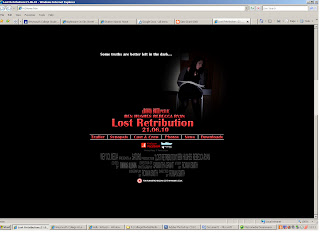 For our individual tasks, I chose to start my website before my magazine. I conducted my research in a similar fashion to the research we did for the trailer, specifically looking at ‘A Nightmare on Elm Street’ and ‘Shutter Island’ as examples to base my own text on.
For our individual tasks, I chose to start my website before my magazine. I conducted my research in a similar fashion to the research we did for the trailer, specifically looking at ‘A Nightmare on Elm Street’ and ‘Shutter Island’ as examples to base my own text on.I was comfortable using Photoshop to create this aspect of my viral campaign, as I am used to using this software as part of my other studies, however I was still able to draw on the new skills I had acquired from workshops that were specifically for webpage design using the programme. This, along with my previous knowledge, meant that I was able to create a product that I think successfully promotes my film.
From looking at these sites, I was able to again draw on codes and conventions that should be applied to a film of the thriller genre. Previous to conducting my research, I had decided to use a dark colour scheme in order to emphasise the chosen genre of my film to my target audience, showing fear and helping to create tension. From looking at websites for existing media products, I was also able to make my own website look as professional as was possible with the software and knowledge available to me. Both ‘A Nightmare on Elm Street’ and ‘Shutter Island’ use the same technique when placing the title of their campaigns along with release dates. This was a convention that was new to me because before starting my research, I had intended to put this information at the top of my website, along with my links. However, after trying to challenge this convention when creating my own site, I decided to instead conform to it and place my title and release date in a similar fashion. This is because it worked better placed in the centre of the page, as when the audience look at the site, it is then the first element they see, and so it becomes memorable, rather than being put in a corner where it then becomes forgettable.
A convention of the ‘Shutter Island’ website was that one of the pictures of a main character that was featured on the homepage was placed off centre. I think this looked really effective, and so chose to adopt this element into my own piece. I then developed this convention by using the picture to play on and reflect the meaning of the tagline to our campaign. By placing the picture off centre, I was able to play on the tagline “Some truths are better left in the dark” by leaving the area next to the picture black.
Another convention that was featured in both of my research examples was the inclusion of legal information, or credits. As this was used in my examples, I felt that I should include this on my own website in order to increase the overall professional look of the site, as well as show the rating of the film, and who was involved with which aspect. I also noted that on both of my examples, there were links to social networking site. I felt that it was important for me to include these on my own site as the brief was to create a viral campaign, and so by including these links, it would enable the target audience to share the website with other people, meaning it would reach a wider range of people and eventually become viral.
 When creating my magazine cover, there were also codes and conventions that I stuck to from looking at my research. Originally I decided that I wanted to make a cover for ‘Empire’ magazine. I felt that this would be the best magazine to promote our film because of my chosen target audience. The ideal audience member for my campaign would be an adolescent male, who is interested in activities such as social networking, games, films and music. This made me think that ‘Empire’ was best suited for my film because their target audience is similar to mine. With this in mind I began to make my magazine cover for ‘Empire’, however as the process continued, I found there were problems that would stop me producing a media text that I would be happy with and that promotes my film in the way that I wanted it to. The main thing I had problems with was finding a suitable background to use, as one of the main codes and conventions that ‘Empire’ follows is to cut out their photos and put them onto a coloured background. Because this was an important convention, I felt that if I was to make an ‘Empire’ cover, then I would need to follow this, however I had problems when trying to cut out my actor in Photoshop, as well as making an effective background. Because of these problems, I decided to change and create a cover for Sight and Sound. I think this worked really well in the end because I was able to stick to the codes and conventions of the magazine, which enabled me to create a media text that was as close to a real product as possible. I think I stuck to the codes and conventions of Sight and Sound magazine as closely as possible, for example I used a whole photo for the background to the magazine cover. I like this because it meant that I could include the location of the film, as well as both protagonists on the front cover, meaning I could tell the audience as much as possible about the film in a limited space. Another convention of Sight and Sound that I followed was the minimal approach to headlines that are featured on the cover of each issue. On some of the examples that I looked at in my research, the only headlines that were featured on the cover were the main title focusing on the featured film, as well as a ‘Plus’ headline with several headlines underneath it about other articles that are featured in the issue. I followed this convention because I felt that it would enable me to promote my film in an appropriate and effective way, through using simply one headline and a picture showing different aspects of my film.
When creating my magazine cover, there were also codes and conventions that I stuck to from looking at my research. Originally I decided that I wanted to make a cover for ‘Empire’ magazine. I felt that this would be the best magazine to promote our film because of my chosen target audience. The ideal audience member for my campaign would be an adolescent male, who is interested in activities such as social networking, games, films and music. This made me think that ‘Empire’ was best suited for my film because their target audience is similar to mine. With this in mind I began to make my magazine cover for ‘Empire’, however as the process continued, I found there were problems that would stop me producing a media text that I would be happy with and that promotes my film in the way that I wanted it to. The main thing I had problems with was finding a suitable background to use, as one of the main codes and conventions that ‘Empire’ follows is to cut out their photos and put them onto a coloured background. Because this was an important convention, I felt that if I was to make an ‘Empire’ cover, then I would need to follow this, however I had problems when trying to cut out my actor in Photoshop, as well as making an effective background. Because of these problems, I decided to change and create a cover for Sight and Sound. I think this worked really well in the end because I was able to stick to the codes and conventions of the magazine, which enabled me to create a media text that was as close to a real product as possible. I think I stuck to the codes and conventions of Sight and Sound magazine as closely as possible, for example I used a whole photo for the background to the magazine cover. I like this because it meant that I could include the location of the film, as well as both protagonists on the front cover, meaning I could tell the audience as much as possible about the film in a limited space. Another convention of Sight and Sound that I followed was the minimal approach to headlines that are featured on the cover of each issue. On some of the examples that I looked at in my research, the only headlines that were featured on the cover were the main title focusing on the featured film, as well as a ‘Plus’ headline with several headlines underneath it about other articles that are featured in the issue. I followed this convention because I felt that it would enable me to promote my film in an appropriate and effective way, through using simply one headline and a picture showing different aspects of my film.To accompany the trailer, we had to create a magazine cover, website homepage and radio advert. This helped to make the campaign as a whole have more effect as a viral campaign, as these are texts that will be easily available to the target audience of the media product. The idea of having a combination of different texts in order to promote one product is to make the audience more aware of the product through advertising it to them in different forms. The desired effect of this is to make the product memorable to the audience, through use of taglines, logos, characters, or other memorable elements, therefore tempting them into going to watch the film in order to find out more about it.
My interpretation of the brief was to create a film trailer as the main product, and then produce the three other texts in order to accompany the trailer, and for them to help promote the main media product in the way I think is the best for our chosen target audience. Because of this, I had to use certain elements throughout each of my media texts. This helped create continuity, as well as making the campaign memorable to my target audience in order that they go and see the film or consume the other media products I created. In both my trailer and website homepage, I decided to use the tagline to the film. I think it is a memorable tagline, and so to use it in both of these elements creates a feature of the campaign that is memorable to the audience. The reason I haven’t used them in my radio advert and magazine cover is because I don’t think it would have been appropriate to include them. The reason for not including it on my magazine cover is because on the covers of Sight and Sound that I analysed for my research, no film slogans were used, and so if I were to use mine on my own cover, I think it would go against the conventions of the magazine and so wouldn’t truly reflect an existing media product. I also didn’t use the tagline for the film in my radio advert, for the same reason. I don’t think it would have fitted with the rest of the radio advert, because of decided to use a rhyme as the main speech element for the advert. I think that if we were to add the tagline into the radio advert, it would have sounded out of place, and would have taken away from the effect of the rhyme that we used. I also decided to use a heartbeat within the radio advert, as I think this helps to emphasise the genre of the film by building tension. As well as this, we chose to use the beat of the bass drum, as we did in the trailer. This again adds to the continuity aspect, and adds to the tension that is created because it is a distinctive sound that you would expect to hear within media texts relating to this kind of media product.
A strong and obvious convention of a thriller genre film is to create tension and build it throughout the media texts. This is because the audience know what they expect from a thriller genre film, and so will want to see this throughout whatever media products that advertise the film that they see. In order to conform to this code and convention, I used dark colours in my website homepage, which I think works well with the dark lighting in my trailer, and I also used red coloured font on the homepage to evoke the idea of fear. I think the photo I used on my magazine cover reflects a thriller genre film because of the positioning of the characters. I chose to have the female protagonist looking at the camera, and therefore the audience, because I wanted to show that she is more vulnerable than the male protagonist, which reflects the common stereotype of women being weaker than men. In contrast to this, I chose to have the male protagonist looking away from the camera to show that he has more dominance throughout the film. I chose to have them back to back at the left edge of the frame to show that they are a team, and are both protagonists, and I edited the sky in the photo to give it a more dramatic effect. I think this again reflects that the film is a thriller because you would expect the environment that the film is set in to be dark, and by having a dark, cloudy sky, it would generally evoke the idea that something bad is going to happen in the film, due to the bad weather.
In terms of how well each element of my campaign work together, I think they do work well as a package. This is because although each element is different in some ways, for example the different aspects I chose to use in each text, they all show the film in the way I want them to. For example, I think they all show tension, reflecting the genre of the film, and I think they all successfully target my chosen audience for the film. I believe that if the target audience were to consume one product from my campaign, then they would instantly recognise the brand if they were to see my other texts in other places. For example in my visual texts, I have used photos of my two main protagonists, and so they will be easily recognisable when they are seen in different places.
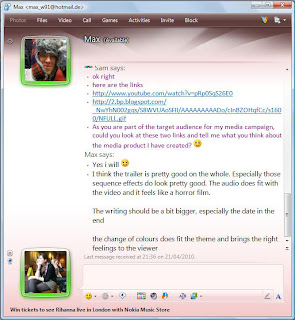 As part of the evaluative process, I got a range of audience feedback from members of our target audience. When I got some of my audience feedback, not all of the components of my viral campaign were fully completed, however I still think there was enough to get some feedbakc that was valuable. When all of the components were then finished, I again got audience feedback on my viral campaign as a whole package.
As part of the evaluative process, I got a range of audience feedback from members of our target audience. When I got some of my audience feedback, not all of the components of my viral campaign were fully completed, however I still think there was enough to get some feedbakc that was valuable. When all of the components were then finished, I again got audience feedback on my viral campaign as a whole package.When my first audience member looked at both the film trailer and my finished webpage, they came to the conclusion that the two components worked well together. The main conclusion I drew from this that my audience member felt that the right codes and conventions had been used, in terms of colour schemes and audio. From this first piece of audience feedback, a criticism of the work is that the text could be a bit bigger. I think this is a valid point because if the text were to be bigger, it was be more dominant in the frame, and therefore would become more memorable to the audience. However, I also think that if the text were to be too big, then it would distract from everything else within the frame and would look amateur and out of place.
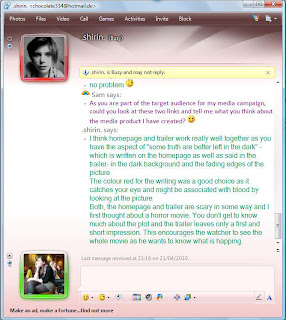 I did the same with a second audience member. Although this audience member was a female, which doesn't directly match the target audience we catered for, which is male, I think that it is still relevant for females to see our campaign because there is a small proportion that may be interested in our film. With this is mind, I showed her the trailer and my website homepage and asked her what she thought. The feedbakc that she gave me showed that she thinks the two elements of the campaign work well together, and she likes the choice of colours that have been used in both elements. She also thinks that the two components of the campaign work well together, in a similar way to my first audience member.
I did the same with a second audience member. Although this audience member was a female, which doesn't directly match the target audience we catered for, which is male, I think that it is still relevant for females to see our campaign because there is a small proportion that may be interested in our film. With this is mind, I showed her the trailer and my website homepage and asked her what she thought. The feedbakc that she gave me showed that she thinks the two elements of the campaign work well together, and she likes the choice of colours that have been used in both elements. She also thinks that the two components of the campaign work well together, in a similar way to my first audience member.Technology has played a big part in the construction of my viral campaign throughout the whole process. I have used many different programmes and techniques in order to complete my campaign, which has meant that I have learnt lots of new skills, as well as being able to develop skills that I had already previously acquired. During the research process, the main technology that I used was the internet to analyse existing media products, as well as to help with my genre and audience research, which was straightforward. In order to present my research for my magazine and website in a different way, I decided to take print screens of my chosen research, and then take them into Photoshop and do my analysis by putting annotations onto the image, then flattening it and uploading them onto Blogger. This was a new method for me, and I think it worked really well. As well as being effective, I think it is a better way to present my research as it makes everything more interesting due to it being more visual rather than a vast amount of writing. As well as this, I also found it easier to explain myself when analysing my research because I could point to specific aspects on the piece of research, rather than try to explain them in a big block of writing. I found this method much more interesting to do, and also much more interesting to look at.
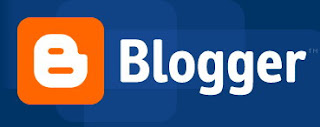
Throughout the whole process of creating my viral campaign, I have been using Blogger to track my progress. I had never used this technology before so I had to learn how to use it. Although it is relatively simple to use, I still had to get used to how it worked, and how to do extra things such as embed video and make links to my other work. I think this has been a really good way to show the process of creatinig my viral campaign because I have been able to upload and write about everything as I have been doing it. I hav
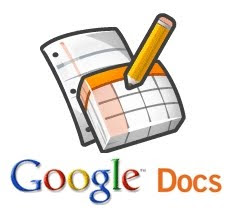 e also been using Google Documents in order to upload my work onto Blogger, which was another new process for me. As well as being able to link to my work on Blogger using this technology, I was also able to share everything with my fellow group members, and they could do the same with me. This made communication much easier because it saved a lot of time when we wanted to share any documents we had created as a group. This was also good because it meant we could share our work when we weren't in college, or if there was a problem with absence.
e also been using Google Documents in order to upload my work onto Blogger, which was another new process for me. As well as being able to link to my work on Blogger using this technology, I was also able to share everything with my fellow group members, and they could do the same with me. This made communication much easier because it saved a lot of time when we wanted to share any documents we had created as a group. This was also good because it meant we could share our work when we weren't in college, or if there was a problem with absence.When constructing my viral campaign, I used a variety of different media taechnologies to make my media texts look as professional as possible. When editing my trailer, Adobe Premiere was used, which was another piece of new software that I had to learn to use. Last yea
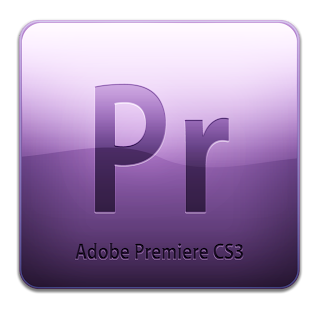 r, when editing, Windows Movie Maker was used, which is a simpler programme, with similar features to that of Premiere. The group had the choice between these two programmes to edit this years work, however our group decided to use Premiere. This was because we wanted to learn new skills, and felt that by using a more advanced programme, we would be able to produce a film that looked more professional. Another reason behind choosing Premiere over Windows Movie Maker was because we had an idea of what effects we wanted to use in our trailer to make it seem as realistic as possible, and we felt that Movie Maker wouldn't be able to provide us with the effects we wanted. When we started to use Premiere to edit our film, I found it relatively simple to use. It worked in a similar way to Movie Maker, so all we had to learn was how to apply the different effects, as well as some other small things. I like that we were able to change some of our shots to black and white without the quality being changed, and also that we could add in the effects we wanted, such as the white noise and the still shots I made in Photoshop.
r, when editing, Windows Movie Maker was used, which is a simpler programme, with similar features to that of Premiere. The group had the choice between these two programmes to edit this years work, however our group decided to use Premiere. This was because we wanted to learn new skills, and felt that by using a more advanced programme, we would be able to produce a film that looked more professional. Another reason behind choosing Premiere over Windows Movie Maker was because we had an idea of what effects we wanted to use in our trailer to make it seem as realistic as possible, and we felt that Movie Maker wouldn't be able to provide us with the effects we wanted. When we started to use Premiere to edit our film, I found it relatively simple to use. It worked in a similar way to Movie Maker, so all we had to learn was how to apply the different effects, as well as some other small things. I like that we were able to change some of our shots to black and white without the quality being changed, and also that we could add in the effects we wanted, such as the white noise and the still shots I made in Photoshop.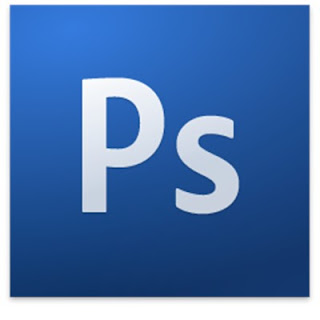 When creating both my website homepage and my magazine cover, I used Photoshop. I am comfortable and confident when using this programme as I am used to using it within my other studies, and I think this helped me to produce to media texts that I am very happy with and promote my film in the way that I wanted. Although I can use this programme confidently, there were still new skills that I learnt through workshops ran by my lecturer, for example I learnt how to change the kerning and leading of my text in order to make it look more realistic, like the text found in my research. By using my skills, I think both my magazine cover and website homepage are effective, and promote my campaign in the best way possible.
When creating both my website homepage and my magazine cover, I used Photoshop. I am comfortable and confident when using this programme as I am used to using it within my other studies, and I think this helped me to produce to media texts that I am very happy with and promote my film in the way that I wanted. Although I can use this programme confidently, there were still new skills that I learnt through workshops ran by my lecturer, for example I learnt how to change the kerning and leading of my text in order to make it look more realistic, like the text found in my research. By using my skills, I think both my magazine cover and website homepage are effective, and promote my campaign in the best way possible.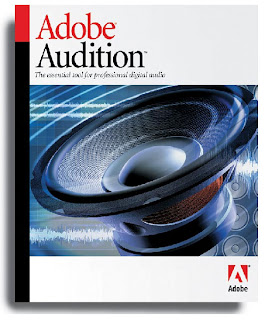 Another new programme that I used in order to complete making my viral campaign was Adobe Audition. I used this programme to edit together my radio advert. This again was a new piece of technology that I had to learn to use, however I picked it up quickly because in some ways it is similar to both Photoshop and Premiere. We didn't want to do anything drastic to our radio advert, so it was mainly just a case of putting the different sound clips together, and cutting them down. The main thing we had to change was the heartbeat. The original clip didn't sound like we wanted it to, so we had to cut bits out in order to make the rhythm we wanted. As well as this, we changed the speed of the clip in order make it more effective. This also helped us to create tension within the radio advert because we made it quicker. With the other sound clips, the main thing we had to change was the volume. This was so that all the different sound tracks could be heard, but the effects, such as the heartbeat, weren't louder than the speech, which was the most important element.
Another new programme that I used in order to complete making my viral campaign was Adobe Audition. I used this programme to edit together my radio advert. This again was a new piece of technology that I had to learn to use, however I picked it up quickly because in some ways it is similar to both Photoshop and Premiere. We didn't want to do anything drastic to our radio advert, so it was mainly just a case of putting the different sound clips together, and cutting them down. The main thing we had to change was the heartbeat. The original clip didn't sound like we wanted it to, so we had to cut bits out in order to make the rhythm we wanted. As well as this, we changed the speed of the clip in order make it more effective. This also helped us to create tension within the radio advert because we made it quicker. With the other sound clips, the main thing we had to change was the volume. This was so that all the different sound tracks could be heard, but the effects, such as the heartbeat, weren't louder than the speech, which was the most important element.During the evaluation process, I again used Blogger to present my work. As well as this, I also used the internet to find the right logos to represent each programme I used throughout making the viral campaign.
In comparison to the coursework I produced for AS, I think this has turned out much better, and as a whole I am much happier with what I have produced this year, compared to last. I think this is beacause the dynamics in the group were much better, and I worked better with thisyears group members. I also think that this years work was planned much better, which I think was vital because there were four different components that needed to be completed. This meant that time management was vital because everything needed to be completed on schedule, and we had to allow time for shhoting and editing, which had the potential to take longer than planned incase there were certain issues that may have arisen.
The main difference between the AS coursework and my A2 coursework was firstly the amount of work that had to be produced for each. For the AS coursework, we had to produce a Preliminary Exercise as well as the opening sequence to a film. This is much different to what we had to produce this year, as this years work involved creating a whole campaign, meaning we had to focus on branding our media product and promoting it in an appropriate way.
Another difference between the two pieces of coursework is that in the AS work, the opening sequence of the film focuses on narrative. This is because with the opening sequence of the film you need to make the audience want to watch the rest of the film, and so by having as much narrative in the opening sequence as possible, this is more likely to happen because it will keep the audience interested in what they are watching. In comparison to this, the A2 coursework focuses strongly on genre rather than narrative. This is because with a trailer you are encouraging people to go and watch the film, rather than trying to tell them too much about the narrative featured within the film. This is because if the audience find out what is going to happen in the film just by watching the trailer, they won't want to go and watch the film. The A2 coursework is all about attracting a target audience, and encouraging them to go and see the film when it is released. It is also about making the audience as aware of the film as possible by using different media forms in order to expose them to the campaign. By doing this, the film will then become more memorable to them, and they will be more likely to go and see it.
Friday, 16 April 2010
Trailer Research - Inglourious Basterds
To identify the codes and conventions commonly used in teaser trailers which promote films within the genres of thriller and action.
Case Study:
Inglourious Basterds (Quentin Tarantino, 2009)
Inglourious Basterds used a different narrative structure again when comparing to the other two trailers. Whereas Cloverfield used a short continuous sequence and Inception used various scenes from throughout the film, this trailer used a mix of these ideas. It was essentially a collage of significant scenes from the film held together by one main scene in which the main character played by Brad Pitt is talking to his men.
This tactic allowed them to establish the setting and to some degree the relationship between the men. It also revealed the nature of their quest and some of the ways in which they were going to complete it. This approach is distinctly different to the other two trailers as the audience has been given far more information and as such the enigma is not as strongly established. However, as with all trailers the resolution of the storyline remains a mystery and in some cases such as this that is enough to capture the minds of the audience.
They also edited in a pieces of text in order to further establish the setting and basic storyline. Like with Cloverfield the production companies and other credits were not mentioned on the trailer and it was in fact only the name of the director Quentin Tarentino that was mentioned within the trailer. I believe there is a certain tactical element to mentioning Taentino’s name within the trailer as he is a very well known and distinctive director with a wide fan base. His films are famous for their distinctive style of real and sometimes shocking depictions of world events, therefore putting his name in the trailer acts as an extra point of promotion from the trailer.
This film used a combination of diegetic and non-diegetic sound which was once again different to the other two trailers which either used completely diegetic (Cloverfield) or completely non-diegetic (Inception) sound. The diegetic sound in this trailer was primarily Brad’s dialogue which acted as a form of narration to outline the premise of the film. There was also a scene used towards the end in which ‘Hitler’ was shouting ‘nein’ repeatedly which was then followed by Brad Pitt closing the speech to his men. The juxtaposition of these two clips gave the impression that there is a small comical element within the film at least as far as you can make killing and war comical. The non-diegetic sound however was music which used instruments such as bass guitars and other instruments associated with some forms of heavier rock music. It provided a feeling of action and excitement which resembles the shots used to create the trailer.
Trailer Research - Inception
To identify the codes and conventions commonly used in teaser trailers which promote films within the genres of thriller and action.
Case Study:
Inception (Christopher Nolan, 2010)
The teaser trailer for Inception is incredibly different from that of Cloverfield. To begin with it is 46 seconds shorter at just over 1 minute long. It also uses a mix of CGI and traditional film. It follows the more conventional teaser trailer style by skipping through time to particular scenes of action. This method allows the audience to see some of the more enthralling moments within the film and seeing as the job of the teaser trailer is to invoke a desire to consume the text this method is very popular.
Another major difference with the Cloverfield trailer is the fact that no diegetic sound is used throughout. The non-diegetic sound used is a mixture of percussion used in a slow and deliberate manner and a sharp note which increases in pitch throughout the trailer. The pace of the beat alongside the increasing tone of the music was used to build tension within the audience.
The main character which the audience is expected to identify with is clearly established in this trailer in Leonardo DiCaprio. There are a number of close up shots which seem to indicate he is of significant importance within the film. As Leonardo is a well known actor and seemingly the main character, including him in the trailer is likely to attract many of his fans from previous films thus enhancing the success of the marketing campaign.
The additional information provided within the trailer included the production company, Leonardo DiCaprio’s name, a line of text which sets up an enigma, the date of release, name of the film and other noteworthy people and companies involved in the production. This being said little about the film’s storyline was actually revealed again in order to create an enigma. The parts that were shown in the trailer included scenes where gravity itself was being defied, and such an enigma as this will undoubtedly spark the curiosity desired to get the audience of the trailer to watch the film itself.
Trailer Research - Cloverfield
To identify the codes and conventions commonly used in teaser trailers which promote films within the genres of thriller and action.
Case Study:
Cloverfield (Matt Reeves, 2008)
Cloverfield’s whole viral marketing campaign was one of the most creative developments in the use of the internet and the power of social networking in film history. It seemed to use the philosophy ‘less is more’ and by this approach the blogs and fan pages were sent into overdrive.
They essentially managed to create an enigma that captured the minds of the public. This created a buzz which reverberated across the worldwide web in an unparalleled fashion. As such, the film gained huge amounts of below-the-line promotion through word of mouth and speculation on the identity of this destructive force.
The trailer used a short sequence from the film with a few points of ellipsis used to create the timeframe required for the trailer. This differed from many teaser trailers which often skip between different significant points within the film in a manner disassociated with the actual timeline of the film. Within the sequence used there was an establishment of setting particularly when the Statue of Liberty’s head rolled down the street and an establishment of characters to a certain degree though this was very vague. Using such a limited section of the film seemed to be part of the ‘less is more’ marketing strategy as the audience was only given one point of reference within the film from which to try and answer the plethora of questions it left behind. Not even the title of the film was put in the teaser trailer, in fact only the name of the producer J.J. Abrams and the release date were given.
The camera was hand held when filming Cloverfield which acts like a constant point-of-view shot thus allowing the audiences perspective to be more subjective and thus ‘realistic’. They also only used diegetic sound within the trailer which is again fairly atypical of teaser trailers but again it does add to the verisimilitude of the trailer.
The shots often became broken and out of focus in order to denote a state of panic and confusion. The trailer relied on this confusion transferring into the audience for the enigma to be enhanced. Further techniques were employed in order to create this state of panic and confusion for example, the camera was often uneven and in the scene where they were running down the stairs it appeared to go upside down at one point during a near rolling action. In addition to this frequent cuts were used throughout the trailer which gave it a fast paced feel.
Thursday, 15 April 2010
Production Photos




 This was when we recorded the voice over for our trailer. I was in control of monitoring the sound levels during the recording.
This was when we recorded the voice over for our trailer. I was in control of monitoring the sound levels during the recording.
Wednesday, 14 April 2010
Website

My final website (click to enlarge)
In order to complete my website, the first of the two individual coursework tasks, I had to set aside time outside of lessons. This was because the group tasks - both the trailer and the radio advert - were what our group felt were most important to focus on in class time together. I think this was the right decision as the individual tasks are much less demanding than the group tasks.
To create our websites, we used Photoshop, which wasn't much of a problem for me as I have experience using this programme within my other studies. Although this was the case, I still feel that I learnt many new skills from the workshops we did in class, as with this subject I have used Photoshop for different things than I do normally in my other studies. With this new knowledge and also my skills that have been previously acquired, I have produced a website that I am happy with, and feel portrays the best of my skills.
Before I created my own website, I researched other films of a similar genre to our own - thriller. The main two films I chose to focus my research on were 'A Nightmare on Elm Street' and 'Shutter Island', both of which are new films. At the time I looked at these two websites originally, both were waiting to be released into cinema, however when I looked at them during the production of my website, 'Shutter Island' has been released into cinemas, whereas 'A Nightmare on Elm Street' was still waiting to be released. This meant that the focus of the 'Shutter Island' website was to encourage people to go to the cinema to watch it, whereas the focus of the 'A Nightmare on Elm Street' website was to encourage people to take an interest in the film before it is released. As well as looking into other websites that are of a similar genre to my own film, I also conducted a SWOT analysis.
Here is the research I did on each of these two websites, with notes about aspects of each website that stood out to me when I first looked at each site. Click on each image to enlarge it and read my notes.




After looking at these websites, I started to create my own, with aspects of the sites from my research in mind. I decided to use a black background as I thought this suited the genre of our film, because a dark colour scheme or background usually connotes that the film is also 'dark. I also thought this colour would work well with the photo I had decided to use. In order to reflect the tagline of our film - "Some truths are better left in the dark" - I feathered the edge of the photo. This makes it look as though something is being concealed, and further plays on the idea of the tagline that some things shouldn't be known by either the characters within the film, or the audience intending to watch the film, which creates a sense of curiosity with the audience, because they want to find out what it is they don't or shouldn't know. To further emphasise the meaning of the tagline, I also only decided to use one photo, and have the left half of the homepage very dark and quite bare in comparison to the right side of the page. This makes the audience believe that there is something they don't know, and it is intended that they will be encouraged to go and watch the film to find out what this is. By choosing a photo where one of the main characters of the film is clearly in a bad situation also helps to evoke the idea that there is something the audience doesn't know about and will need to watch the film in order to discover what this is. I also decided that I wanted to put the rating of the film onto the website. This is because it is a legal formality, and was also on both of the examples I looked at in my research. Before I started to create my website, I decided that any legal information that I was going to include should be at the bottom of the page, and should be relatively small. This is because when a potential audience look at a film website, they are more interested in the content which is directly about the film rather than the legal information that they don't want, or necessarily need, to know.
I have annotated each screenshot I took during the process of creating my first website draft. Click on each photo to enlarge it and read the notes I made.



Here is a screenshot of the first draft of my website (click to enlarge).

Although I was happy with the work I had produced for my first draft, I wasn't convinced that it was effective and worked as a website for a thriller film. The main element that cast doubt in my mind was the positioning of each thing on the page. I felt that I had included all the correct elements within the website, but wasn't happy with the way in which each one was laid out. For example, I wasn't happy with where I had placed the title and release date, as I felt these were less noticeable than other, less important elements, such as the photo. I also wasn't happy with the way I had faded out the edges of the photo, and so later went on to change this. As well as this, I thought that certain things, such as the social networking links at the bottom of the site, looked out of place and didn't work in the places that I had put them.
With all of this in mind, I decided to play around with the layout of the website, changing a few things and trying new things out in order to make sure that my website promoted the film in the best way possible.
Here is a screenshot of the second draft of my website (click to enlarge).

To try and improve my website from my first draft, I firstly put the release date and film title together and made the text slightly bigger, which made it more dominant on the page. I also resized and moved the photo, as well as doing the fading effect again. By moving the photo to the right and also making it higher in the page, I think it conforms closer to the contemporary codes and conventions of film websites. It is also less dominant in the page, which I think is a good thing because it means that more attention is focused on the film title and release date. I also decided to move the photo to the right of the frame because I think it further reflects the tagline of the film. This is because the left of the frame is black, reflecting that "Some truths are better left in the dark". As well as making these changes, I also decided to move the 'toolbar' of links so it was above the credits instead of at the top of the page because I think it looks better when it is grouped with more text. By changing the logos of the social networking sites, as well as their positioning, I think, again, that I have achieved a more professional look.
I think the second draft of my website is an improvement on the first draft, however after looking at this one, I still felt that there was room for improvement, mainly in terms of the title and release date of the film. After moving and changing elements, I still thought that the title and date could still look better, and so decided to carry on moving them around and changing them until I was completely satisfied that they were in the right place on the website.
Here is a screenshot of the third draft of my website (click to enlarge).

The main thing I changed on this draft was the title and release date, as I was relatively happy with the other elements of the website in the previous draft. In order to make the film title and release date look better on the website, I looked again the website of 'Shutter Island'. When I specifically looked at the title on the website, I noticed that it had the name of the director, as well as the name of the lead actor directly above it, and then information saying that the film is in cinemas now directly below it. Because of it's effectiveness and professional look, I decided to try this with my own film title and release date, and think this worked really well. I decided to leave this information in the top left of the frame to continue with the idea of the rule of thirds. I also changed the logos of the social networking sites and the 'toolbar' of links around, to see what this looked like.
Here is a screenshot of the fourth draft of my website (click to enlarge).
I was still unhappy with the positioning of the title and release date of the film in my third draft, so this was the element I focused on getting right in my fourth and final draft. I swapped the tagline and the title elements around because I wanted to see what it would look like if I took it away from the top left of the frame. I think the website works much better when the title of the film and the release date etc are in the centre of the page because I think it becomes the most dominant aspect within the website, which is good because it means it is the first thing that the audience will notice when they look at the website. This positioning also reflects the contemporary codes and conventions of film websites, and is similar to the website of the film 'Shutter Island'.Overall, I was really pleased with the outcome of my website, and think that my film has been advertised in an effective and appropriate way, through the use of text, colours, and by conforming to the codes and conventions of real media products. In order to extend this website and improve it, I would ideally like the make the links live, and be able to include other elements, such as being able to embed the finished trailer and radio advert, as well as create other pages with different information on.
Wednesday, 24 March 2010
Thursday, 18 March 2010
Progress Report - 18/03/10
In terms of our film trailer, we have completed the pre-production, as well as the production, and are into the post-production stage. We filmed our piece over two days - 11th and 12th of March. I think this went really well, and that we all worked well together as a team. Each of us took on our roles, and because we stuck to them, we completed filming on schedule and ensured we had every shot we needed, with several takes of each, working with the storyboards and the script to make sure everything was as we had planned it to be. One issue we did have during filming was lighting levels. We found it difficult to get the lighting levels that we had hoped for, and so had to improvise by using a torch to reach the lighting we wanted. Although this was a solution, we did find it hard to try and make our set look like it wasn't torch lit, and that the light was being sourced from somewhere else. Although this was the case, from watching back the footage we have, I think that the lighitng levels turned out ok, and do make our trailer look effective, if not a little dark.
Because we have included several tracking shots within our trailer, we had to find ways to create these without making the camera look as though it was hand held. In the courtyard scene, we used a wheelchair in order to do this, with Tom pushing myself in the wheelchair, and Rowan overseeing things. As well as this, we are also including a tracking shot in the last sequence of our film, with the camera and the male protagonist both running towards each other. To achieve this shot we used the same concept as the shot in the courtyard, using a computer chair.
Throughout the filming stage, we also took production stills, as well as stills for the other aspects of our coursework. By taking this time for both filming and production stills (4-5hours in total)we made sure that we has several takes of each shot to make sure we had a choice of which one to use when it came to the editing stage. After filming on each day, we made sure that we took time as a group to go over the footage we had taken to make sure that everything was how we wanted it, and that if there were any problems we could think of ways to rectify them.
At the moment, we are in the editing stage with our trailer. We are getting to grips with using Adobe Premier, a new programme which we have never used before. Although Tom is the editor within the group, we are all taking an active role in deciding which takes should be used, and also any other decision such as when we should cut each shot. When we were capturing our footage, we made sure we logged each shot, and gave it a number. When it came to then putting together our rough cut, it was much easier to find the shots and assemble them into the right order.
As we are editing the trailer, we are tying out the different effects that we think would work well with our chosen genre, and will make the trailer look effective. For example, we chose to put our CCTV shots into black and white, and use red text in the bottom right corner saying "Recording" to make it look more realistic and effective. We have also decided to use white noise in several places to make the transition between the CCTV shots more professional. With the CCTV shot of our female protagonist in the library, we have chosen to to use visual white noise as well as the sound to show that she has disappeared. This helps to build tension because the audience will want to know how and why she has disappeared, thus wanting to go and watch the film. To show that the CCTV shots are changing, we also made it look as though the frames were fuzzy as they were changing. In order to do this, I took a still frame of the CCTV shot that we wanted to change to and in Photoshop put a filter on it to make it look fuzzy and misplaced. We then put these stills infront of the CCTV shots we were changing for a split second to to make it look as though the channel was changing. Another effect we used was the grain effect. We used this on the last shot where the female protagonist is answering a question that she asked early in the trailer. We decided to put a grain as well as the "Recording" text in red on this frame to make it look realistic because the whole idea of the film is that the two protagonists are making a documentary around their college. The grain makes the quality of the image look lower and so this is realistic because it is what the audience would exoect a sort of 'home movie' to look like. The "Recording" text in the corner of the frame helps to add to this effect.
Instead of using diegetic sound within our trailer, we will be using a voice over which we have pre-recorded in the radio studio with our actress. When producing this element of our trailer, we again all took on our specific roles to make sure everything went according to plan. I was the monitoring the sound and doing the recording, and Rowan and Tom were helping Becca (our actress) to read the script in the way we wanted in order to add the right effect to the trailer, which we hope will add to the tension we want to create. When we cut and use this voice over to add to our trailer, Tom will be able to cut it in the right places to fit with the visual aspect. This is because before we started to record the voice over, we briefed Becca, telling her how we wanted her to speak and giving her time to practice with the script. This meant that we were able to fulfill the codes and conventions of our chosen genre as much as possible, and I think that when we add this to the final trailer, it will be effective and accomplish the effect we want.
Friday, 5 March 2010
Location Photos

This is a shot of the front of the college. We have decided to use this as our establishing shot because it tells the audience where the film is going to be set. Having the plinth with the name of the college on in the corner of the shot also tells the audience that the film is set in a college environment, and so from this they can assume that the main characters will probably be young people, who are in education.

We want to use this shot to show our two main protagonists within the college environment. The characters will be stood still, perhaps talking to eachother, and the camera will move around them. The idea behind this shot is to show the characters within the college environment, which will help the audience to make the link that they are students within the college.

This is the second view of the previous shot. As the camera moves around the two characters, this is what will be seen.

This is a CCTV shot of a classroom within the college. The aim of this shot is to show that the college is empty at the time the two protagonists are there, and to also show the audience what the college is like.

This shot will be used to show the male protagonist running past, and when we film we will frame it so that you can only see his feet. This will be the first shot to add tension to the trailer, and will show the audience that eveything isn't what it seems within the college. It will also give the audience an idea that something or someone is in the college, and the idea is to make them want to watch the rest of the film.

This is another CCTV shot, and will show the male protagonist running past. This is to portray that he is being chased by something or someone, and will also show that he and the female protagonist have been separated at some point previous to this.

This shot of the library is also a CCTV shot. We intend to show the female protagonist stood in the centre of this shot, looking straight at the camera, with a blank expression on her face. The aim of this shot is to reinforce to the audience that our chosen genre is a thriller. By having a blank expression on her face, we want the female protagonist to look like she is posessed, and that the antagonist has some kind of power over her. I also think that by including this shot, we will show that it is the female protagonist is vulnberable compared to the male protagonist, which supports the stereotype that women are vulnerable compared to men.

We will use this shot to show the antagonist following the male protagonist. The male protagonist will be stood in the hallway, and the camera will move out from behind the wall and begin to walk towards him. This shows that audience that the protagonists don't know the antagonist is following them, and it also tells them that something sinister is happening within the college, however it doesn't identify the reason behind this.

This is a shot of the same corridor that we will use in the previous shot. In this shot, we intend to show the male protagonist turning round because he thinks somebody or something is behind him, however when he turns round there will be nothing behind him. This will again support the conventions of a thriller genre because the audience have been led to believe something else in the previous shot.

After being in the corridor, the male protagonist will then walk into a classroom in the same corridor. The classroom will be in darkness, and he will be looking around the room with a torch. This gives a feeling of tension to the audience because they dont know if he will find anything in the room. Because he is looking around the college, it will also be clear to the audience that he is looking for the girl he was shown with at the beginning of the trailer. In turn this then tells the audience that something untoward has happened to her and that they have somehow been separated, which is more than likely because of the actions of the antagonist.

After showing the shot of the male protagonist looking for the female protagonist in the classroom, we will change to a shot of the room where she is being kept. This confirms to the audience that the male protagonist is definately looking for her, but it also tells them that she is in distress and is being held against her will. As a result of this, the audience will want to know what is going to happen to her, and whether he will find her by the end of the film.

This shot will show the male protagonist starting to walk around the room trying to find the female protagonist. We intend this to be a point of view shot, will will help the audience to see things from his point of view.

This is the room where the female protagonist will be 'held' by the antagonist in the film. We chose this room because it is fairly small and so we will be able to make it look crampt, and it we will also be able to make this room very dark which will help add to the tension in the film, and also add to the 'fear factor' that we want to create.

We will use this stairwell to show our male protagonist supposedly searching for the female protagonist. We want to show him looking around the college in different areas, and think this area would work because it is dimly lit. As well as using this shot, we will also be using a point of view shot of the antagonist from the top of the stairwell. In this shot, we want to make it appear as though the antagonist is watching the male protagonist without him knowing. This will help to build the tension of the trailer.

This will be the point of view shot from the antagonist, watching the male protagonist going down the stairs.

We will be using this corridor for the last sequence of our trailer. This is becuase it is a narrow corridor, and is another area of the college that we can make dark in order to fit with the codes and conventions of a thriller genre.

This is the area of the corridor where our male protagonist will trip over. The lighting will be very dark, which we again will add to the tension we wish to create.

This is a view of the same corridor that we will be using in the closing sequence of our trailer. This is the view with the door from the small room where the female protagonist will be being 'held' by the antagonist. We want the audience to know that the male protagonist gets to the room where she is being held, however we don't want them to know if he finds her, or even if he knows she is being held in that room.




